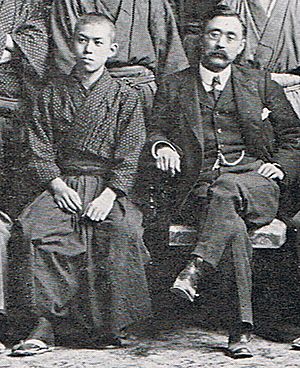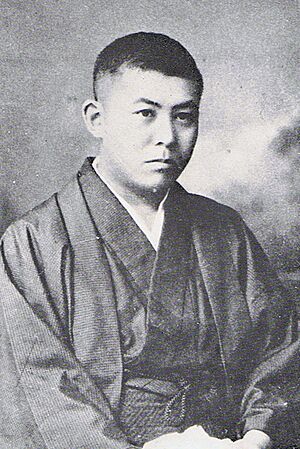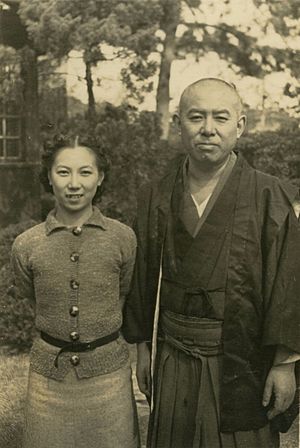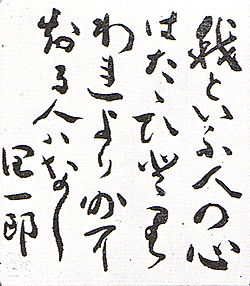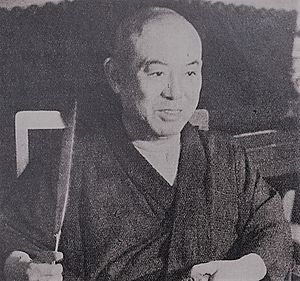Jun'ichirō Tanizaki facts for kids
Quick facts for kids
Tanizaki Jun'ichirō
|
|
|---|---|
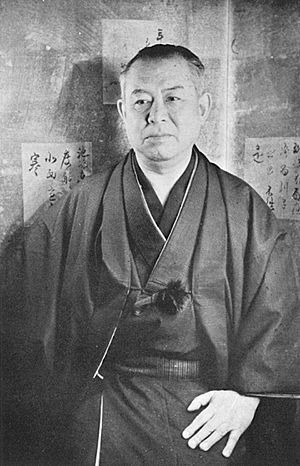
Tanizaki in 1951
|
|
| Native name |
谷崎 潤一郎
|
| Born | 24 July 1886 Nihonbashi, Tokyo, Empire of Japan |
| Died | 30 July 1965 (aged 79) Yugawara, Kanagawa, Japan |
| Occupation | Writer |
| Genre | Fiction, drama, essays, silent film scenarios |
| Spouse |
|
| Children | 2 |
Jun'ichirō Tanizaki (谷崎 潤一郎, Tanizaki Jun'ichirō, 24 July 1886 – 30 July 1965) was a famous Japanese author. He is known as one of the most important writers in modern Japanese literature.
In 1964, just a year before he passed away, he was one of six authors considered for the Nobel Prize in Literature.
Contents
About Jun'ichirō Tanizaki
His Early Life and Family
Tanizaki was born on July 24, 1886, in Nihonbashi, Tokyo. His family was well-off, belonging to the merchant class, which meant they owned businesses. His grandfather had started a printing press that his uncle later owned.
Jun'ichirō was the second son, but his older brother died shortly after birth. He had three younger brothers and three younger sisters. Tanizaki wrote about his childhood in a book called Childhood Years.
When he was young, his home was destroyed in an earthquake in 1894. This event made him afraid of earthquakes for the rest of his life. As he grew up, his family faced money problems. He even had to live with another family for a while, working as a tutor.
Despite these challenges, he went to the Tokyo First Middle School. Later, he studied literature at Tokyo Imperial University. However, he had to leave in 1911 because he could not afford the tuition fees.
Starting His Writing Career
Tanizaki began his writing journey in 1909. His very first work was a short play. It was published in a literary magazine that he helped create.
He became well-known after his short story The Tattooer was published in 1910. Other works from this early period, like Shindo and Oni no men (both from 1916), included some parts of his own life.
Tanizaki married his first wife, Chiyo Ishikawa, in 1915. Their only child, Ayuko, was born in 1916. This marriage was difficult and later ended. The stress from his personal life sometimes appeared in his early plays and novels. However, most of his stories were not directly about his own life, unlike many other writers of his time. He later adopted Emiko, the daughter of his third wife, Matsuko Morita.
In 1918, Tanizaki traveled to Korea, northern China, and Manchuria. In his younger years, he was very interested in Western culture and modern things. In 1922, he moved to Yokohama, a city with many people from other countries. He lived in a Western-style house and enjoyed a free-spirited lifestyle. This interest in Western ideas showed up in some of his early writings.
Tanizaki also worked briefly in silent cinema. He wrote scripts for a film studio and helped bring modern ideas to Japanese movies.
Moving to Kyoto and New Inspirations
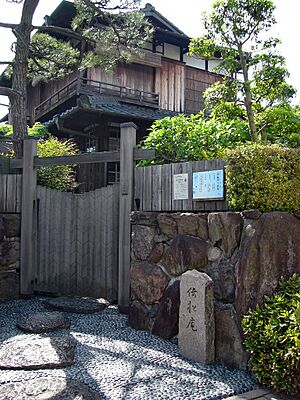
Tanizaki's writing became even more popular after 1923. That year, a huge earthquake, the 1923 Great Kantō earthquake, destroyed his house in Yokohama. Luckily, Tanizaki was on a bus and was safe.
After the earthquake, he moved to Kyoto. The destruction of Tokyo's old buildings changed his mind about things. He started to focus less on Western ideas and more on traditional Japanese art and culture. He especially loved the culture of the Kansai region, which includes cities like Osaka, Kobe, and Kyoto.
His first successful novel after the earthquake was Naomi (1924-25). In 1926, he visited China again and met a writer named Guo Moruo. Tanizaki moved from Kyoto to Kobe in 1928.
His new interest in old Japanese stories led him to translate the classic eleventh-century tale, The Tale of Genji, into modern Japanese. His most famous work from this time is The Makioka Sisters (1943–1948). This novel tells the story of four sisters from a rich Osaka family. It shows how their traditional way of life slowly changes during the early years of World War II. The sisters live a modern life with European friends, but they don't have the same cultural struggles that some of Tanizaki's earlier characters faced.
When he started publishing The Makioka Sisters in a magazine, the editors were told it didn't help with the war effort. Because they were worried about losing paper supplies, they stopped publishing it.
Tanizaki moved to Atami, Shizuoka in 1942, but he returned to Kyoto in 1946.
After World War II
After World War II, Tanizaki became even more famous. He won many awards and was seen as Japan's greatest living author.
He received the important Asahi Prize in 1948. In 1949, the Japanese government gave him the Order of Culture, a very high honor. In 1964, he became an honorary member of the American Academy and Institute of Arts and Letters. He was the first Japanese writer to receive this honor.
His Lasting Impact
The Tanizaki Prize is one of Japan's most important literary awards. It was created in 1965 by a publishing company called Chūō Kōronsha. This prize is given every year for a great work of fiction or drama.
Before Haruki Murakami became widely known, Tanizaki was often considered one of the "Big Three" important Japanese writers after the war, along with Yasunari Kawabata and Yukio Mishima.
See also
 In Spanish: Jun'ichirō Tanizaki para niños
In Spanish: Jun'ichirō Tanizaki para niños


